Salvia clevelandii
If you love growing common sage in your herb garden and live in a warm area, you’ll want to consider adding Cleveland sage into the mix.
Salvia clevelandii, also known as California blue, fragrant, and most often, Cleveland sage, is a fast-growing, highly aromatic herb that is native to the coast of southern California. It’s suitable for cultivation in USDA Hardiness Zones 9-11.
It is a small plant, producing gray-green foliage and leathery leaves. Growing to around four feet tall and wide, this plant bears beautiful blue-violet flowers, and also has fragrant leaves that can be used in cooking.
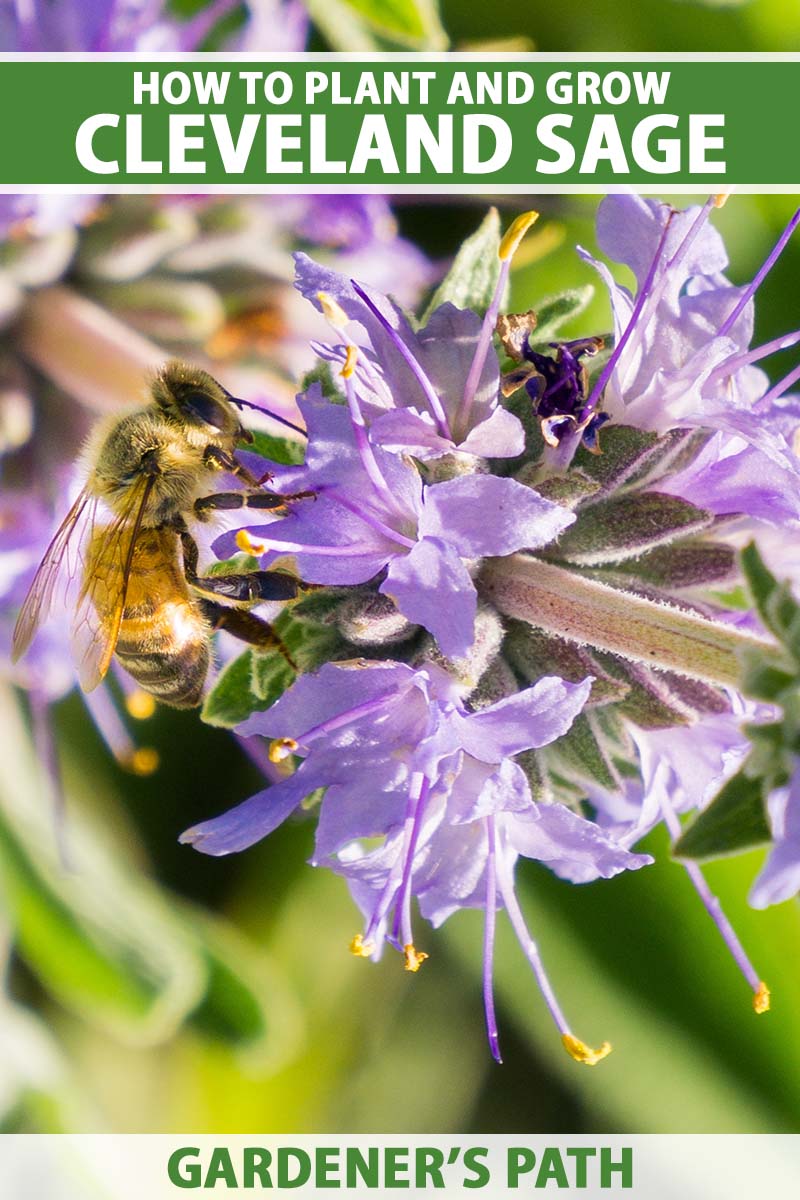
We link to vendors to help you find relevant products. If you buy from one of our links, we may earn a commission.
Known for attracting hummingbirds, this member of the Lamiaceae family is remarkably easy to care for.
In fact, if you have tried growing common sage in the past, you shouldn’t have too much trouble learning the ropes with this attractive species.
You’ll find everything you need to get started below!
What You’ll Learn
Cultivation and History
A heavily scented plant, Cleveland sage is a favorite of bees and humans alike. It smells just like the common type but is known for being much more powerful.
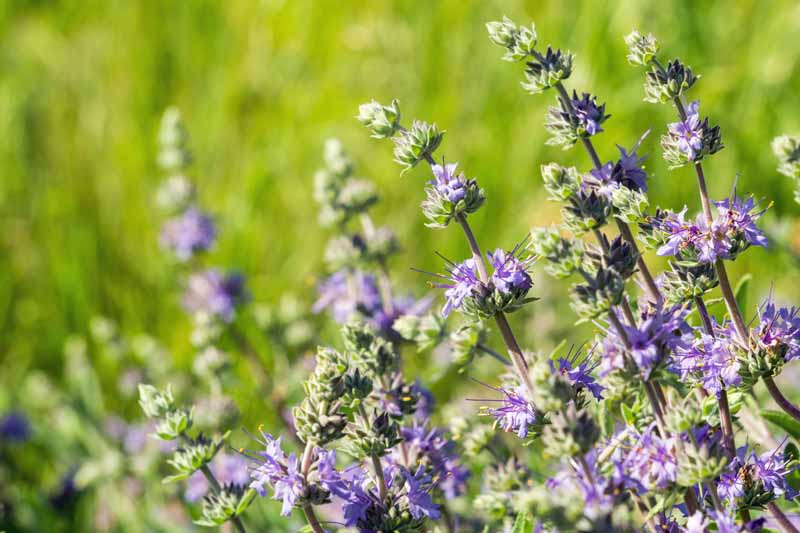
Native to California, with multiple cultivars and hybrids available to the home gardener, this plant was first introduced by the Saratoga Horticultural Foundation in 1981.
Also referred to as blue sage, S. clevelandii is different from S. azurea var. grandiflora, another plant that is often referred to by this name.
There are two explanations given for the common name of this plant. Some suggest that the plant was named after Grover Cleveland, the former president of the United States.
Others argue that the name comes from the fact that this plant is found growing in the Cleveland National Forest in Santa Ysabel, California, which itself also commemorates the name of the president.
Still others suggest that the plant is named in honor of Daniel Cleveland, an amateur botanist and the cofounder of the San Diego Society of Natural History.
The plant has many culinary and medicinal uses.
The Kumeyaay tribes of Baja California use the seeds of the plant to season wheat for added texture and flavor, and burn the leaves for ceremonial smudges, according to botanists at the University of San Diego.
Leaves are frequently used medicinally to relieve respiratory problems, while the seeds can also be ground up and toasted to make a dish named pinole, one that typically contains ground maize but can also be made with sage seeds, as well as cocoa, agave, vanilla, cinnamon, and other spices.
Propagation
Cleveland sage is easy to grow from seed, and seedlings should emerge in 13 to 21 days. They do not need fertilizer, especially if you start with fertile soil.

To start seeds outdoors, you can sow them directly in the ground in spring, after all risk of frost has passed.
Sow seeds 1/8 inch deep in moist soil. Maintain even moisture, but do not let the soil become waterlogged, until germination.
Thin seedlings to 15 inches apart when they have two to three pairs of true leaves.
You may also start seeds indoors six to eight weeks before you intend to plant them out, taking your local average last frost date into consideration.
Plant seeds about 1/8 inch deep in a moist, well-draining seed starting mixture in individual cells about one and a half inches wide and two to three inches deep.
Sow two to three seeds per cell and thin to the strongest seedling once they emerge.
If planting indoors, make sure you put your seed starting containers in direct sunlight or under grow lights, as the seedlings will require about 16 hours of light per day, and eight hours of darkness at night.
If you started your seeds in small cells, you should transplant them to three- or four-inch pots once they have at least two pairs of leaves. This will help them develop stronger roots.
Before transplanting to the garden, take the time to harden off your seedlings. Do this by moving them to a sheltered place outdoors for a week.
On the first day, provide just a few hours of outdoor time. Gradually increase the amount of time over the course of a week until they can spend all day outdoors.
When transplanting, choose a location in full sun, and dig a hole for each plant that is just large enough to accommodate the root ball.
Gently remove the plant and loosen the roots with your fingers. Set each plant about 15 inches apart. Backfill with soil, then press down firmly with your hand. Water thoroughly.
You can also start from stem cuttings or by dividing existing clumps. Our guide to growing sage provides more information.
How to Grow
Plant your Cleveland sage in a location that receives full sun and contains fertile, well-drained soil.
This plant can tolerate a variety of soil types as long as it is well-draining. It grows best in loam or sand, preferring a neutral pH of 6.0 to 8.0. Fertilizing your plants is not necessary as they are not heavy feeders.
Partial shade is also acceptable and even desirable if growing this plant in an extremely hot, dry environment, such as those at the more extreme end of the growing range.
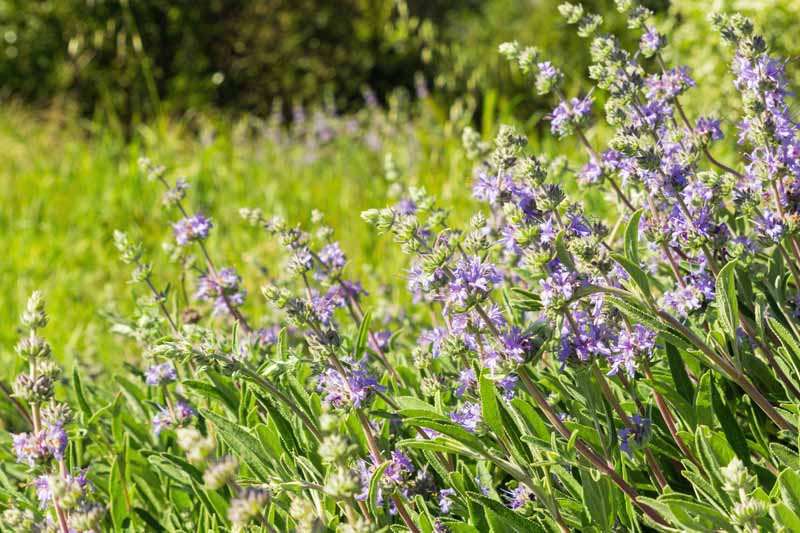
Before planting, turn the soil under to a depth of eight inches and remove any large stones or weeds. You may wish to add a bit of compost or other organic matter to amend the soil before you plant.
Water regularly while your plants are young. For the first few weeks, provide about an inch of water per week in the absence of rain.
Although Cleveland sage is drought-tolerant once established, it cannot tolerate drying out completely when it is young.

Apply a layer of organic mulch, like straw or wood chips, to help conserve moisture and add nutrients back to the soil. Aged bark and shredded leaves also work well.
Keep weeds under control by mulching or removing them by hand.
Growing Tips
- Grow in fertile, well-draining soil.
- Select a location in full sun to partial shade.
- Keep soil moist but not waterlogged.
Pruning and Maintenance
Very little maintenance is required to care for Cleveland sage.
You can deadhead it to extend the blooming season but this is not necessary for the plant’s health. In the fall, it can be pruned to help it maintain a more compact size.
Cultivars to Select
There are several cultivars and hybrids to consider growing as you get started with planting Cleveland sage.
Allen Chickering
Named after Allen Chickering, a noted conservationist in California in the mid-1900s, this hybrid of S. clevelandii and S. leucophylla produces whorls of gorgeous lavender-blue flowers during the summer months.
It’s best for sunny areas and grows to three or four feet tall and wide, with a rounded habit.
Aromas
‘Aromas’ is a cultivar that is a bit larger than the others, growing to four or five feet tall and wide.
It has a rounded habit and is often used as a landscaping plant.
Betsy Clebsch
Another unique cultivar to consider, S. clevelandii ‘Betsy Clebsch’ is named in honor of the noted Northern California amateur botanist and horticulturist of the same name.
This one has lavender and white flowers. It grows in a compact fashion, only reaching about two feet tall and wide.
Winnifred Gilman
‘Winnifred Gilman’ is a rounded plant that produces gray-green leaves and lavender flowers on stems that are 18 to 24 inches tall. It is a smaller variety, growing to just three feet tall and wide. It flowers early in the summer.
Managing Pests and Disease
There are not many pests and diseases to which Cleveland sage is prone. However, you should keep an eye out for nematodes, spittlebugs, and root rot. Fortunately, herbivores don’t care much for this plant!
Nematodes cause damage to plants that mimics the effects of overwatering. The growth of your plants may appear to be stunted and the foliage might turn yellow. Limit watering and make sure the soil has time to dry out.
If nematodes continue to be a problem in a planting site, you may need to choose another for future plantings.
Spittlebugs look much like leafhoppers and deposit their eggs near the soil surface. Nymphs and adults will suck plant juices, causing stunted growth.
Spittlebugs can be handpicked or removed with a quick blast of water from the hose. Insecticidal soap can also be used.
Root rot causes the foliage to turn brown. Caused by a fungal pathogen that favors excess moisture around the roots, it is common in soils that are poorly or slowly draining.
This problem is most easily prevented by keeping plants dry. Let the soil dry completely between waterings and, after the plant is well established, stop watering entirely.
It is drought-tolerant and easily damaged in waterlogged soil. Provide ample spacing around plants for air circulation.
Harvesting and Preserving
The leaves of Cleveland sage can be harvested just as you would harvest leaves from any other sage plant. Cut an entire stem at once, or just pinch a few individual leaves at a time to use in your cooking.
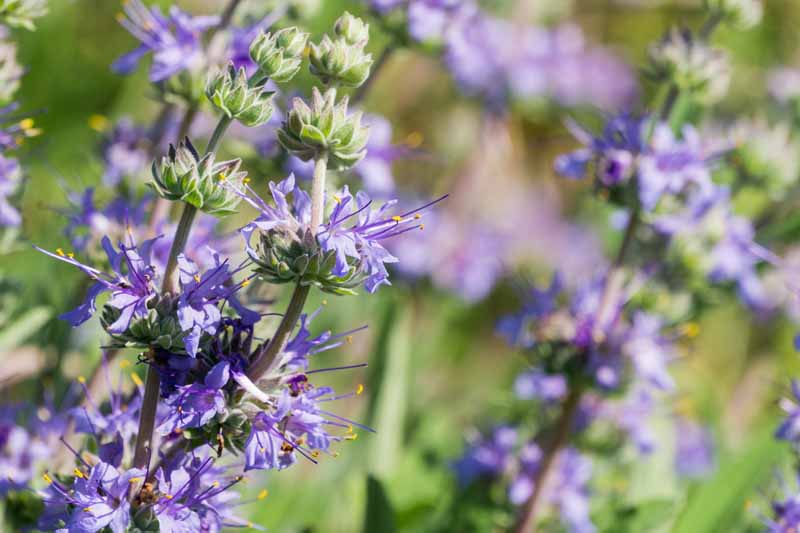
The best flavor will be found when you harvest leaves prior to blooming. It generally takes around 75 days from sowing seeds for the plant to produce harvestable leaves.
Both younger and older leaves can be harvested, but those that are younger will have a better flavor.
When harvesting, be sure to leave a few stalks with their leaves intact so that the plant can recover. Frequent harvesting will encourage the plant to develop a good shape and will reinvigorate it, inviting future growth.
Drying your Cleveland sage leaves is the best method of preserving them. Gather a group of stems together in a bundle, then hang them upside down to dry.
Once dry, you can strip the stems of their leaves and pack the leaves into jars. Store these out of direct sunlight in a dry place.
Get more tips on drying herbs here.
Best Uses
Although many people grow Cleveland sage to harvest its edible and aromatic leaves, it has a variety of other uses as well.
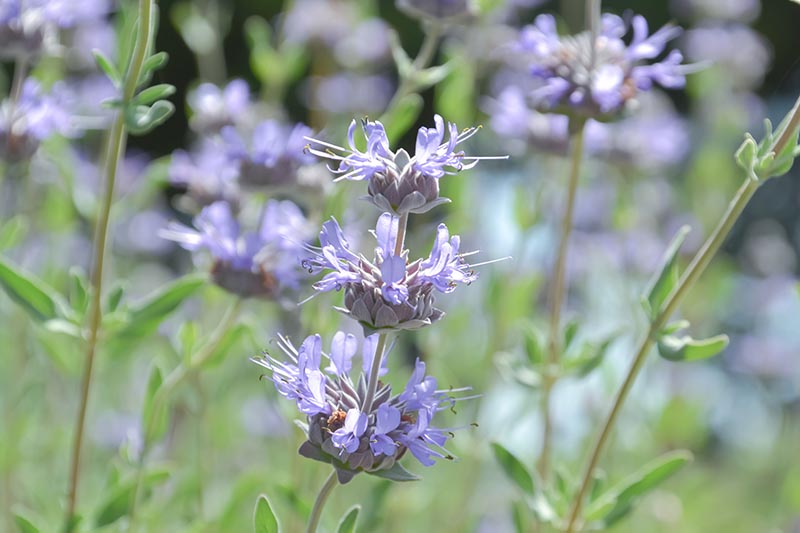
It is frequently grown as a bank stabilizer and to attract pollinators and wildlife like birds, butterflies, bees, and hummingbirds.
It works wonders in an informal flower garden, as well as in containers. It is extremely drought tolerant and is ideal for xeriscaping.
When grown for its edible leaves, this plant can be used much like you would use the leaves of common sage. They provide wonderful seasoning for poultry and fish dishes and can also be used to make fragrant dried sachets.
Quick Reference Growing Guide
| Plant Type: | Perennial herb | Tolerance: | Deer, drought |
| Native to: | California | Maintenance | Low |
| Hardiness (USDA Zone): | 9-11 | Soil Type: | Loam, sand |
| Bloom Time: | Late spring/early summer | Soil pH: | 6.0-8.0 |
| Exposure: | Full sun to part shade | Soil Drainage: | Well-draining |
| Spacing: | 15 inches | Attracts: | Bees, butterflies, hummingbirds |
| Planting Depth: | 1/8 inch (seeds) | Companion Planting: | California buckwheat, California coffeeberry, chamise, coastal prickly pear cactus, white sage, yucca |
| Height: | 4 feet | Uses: | Bank stabilization, container and pollinator gardens, edible leaves |
| Spread: | 4 feet | Family: | Lamiaceae |
| Water Needs: | Low | Genus: | Salvia |
| Common Pests and Disease: | Nematodes, spittlebugs; root rot | Species: | Clevelandii |
The Secret to an Aromatic Garden
Cleveland sage is the ideal plant for the waterwise garden, requiring very little moisture and care once established. With a rounded form and pollinator-attracting blue-purple blooms, this plant is perfect for a backyard garden.

Although it is often grown to add ornamental interest, blooming for well over a month in many cases, its leaves can also be harvested for use in the kitchen.
Often planted in southwestern gardens, there are several cultivars and hybrids of this plant for you to consider.
If a garden that appeals to all of your senses is what you’re after, Cleveland sage is the way to go. It looks beautiful, has delicious tasting leaves that feel soft between your fingers, and smells heavenly.
Are you growing Cleveland sage in your backyard? Let us know in the comments section below!
And for more information about growing herbs in your garden, you’ll find helpful information here:
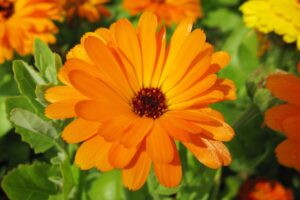
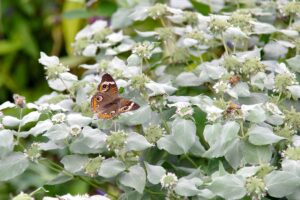

Is it too late (June 23, 2024) to plant any chili type and Cleveland sage? Are there any sprouted plants available at Mesquite Valley Growers on June 29, 2024, thanks much
Unfortunately, I can’t tell you if any starts are available in your area, but if you can find some, it’s not too late to plant them. It’s fine to plant sage, though you’ll want to be selective about the type of chili you plant. It should be an early maturing type like ‘Early Jalapeno’ or a shishito. You’ll also need to be very careful about watering since we are heading into the hottest time of year. Never let the plants dry out too much.